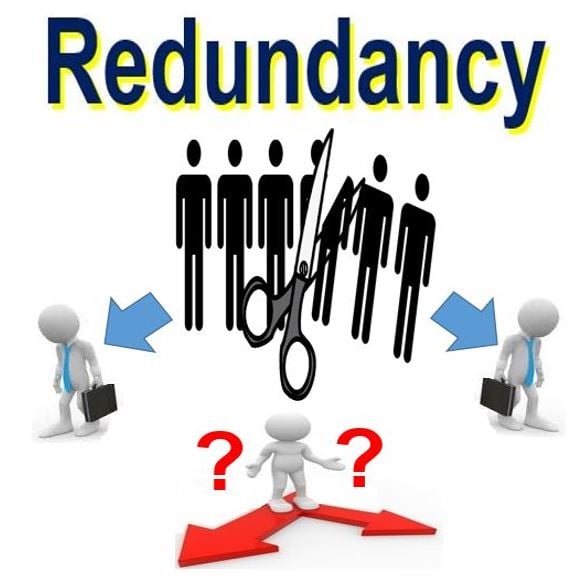Who Pays Redundancy Money? A Detailed Overview for Companies and Employees
Who Pays Redundancy Money? A Detailed Overview for Companies and Employees
Blog Article
Discovering the Operational Characteristics of Firm Redundancy and Its Long-Term Sustainability

Redundancy Techniques for Service Continuity
In order to ensure nonstop operations, companies should execute reliable redundancy approaches for company connection. Redundancy in this context describes the duplication of vital elements or features within a system to minimize the influence of potential failings. By including redundancy techniques, companies can improve their resilience against interruptions triggered by different elements such as all-natural calamities, tools failures, or cyber-attacks.
One common redundancy technique is the execution of back-up systems and data storage space solutions. This includes producing duplicates of necessary data and systems that can be turned on in situation of a key system failure. Additionally, organizations can develop redundant interaction networks and power sources to maintain connectivity and operations during unpredicted occasions.
Moreover, cross-training workers to execute numerous roles within the company can function as a useful redundancy strategy. If key workers are inaccessible due to health problem or various other reasons, this guarantees that important tasks can still be lugged out also. Generally, efficient redundancy methods are vital for services to support operational continuity and minimize the impact of possible disruptions.
Impact of Redundancy on Organizational Strength
Given the important duty redundancy strategies play in making sure company continuity, exploring the impact of redundancy on organizational strength ends up being imperative for understanding the alternative functional characteristics of a company. Business strength refers to an entity's capacity to adjust to interruptions, recuperate from troubles, and transform when essential while keeping core features. Redundancy, when tactically applied, can significantly add to enhancing a company's durability despite unforeseen difficulties. By having back-up systems, personnel, or procedures in position, firms can better withstand shocks and proceed procedures with marginal disturbance.
Moreover, redundancy can bolster staff member morale and confidence, understanding that there are backup plans in area to address unanticipated situations. This feeling of security can result in enhanced efficiency and a more favorable workplace. Additionally, redundancy can cultivate innovation and creative thinking within an organization as workers really feel encouraged to take calculated dangers, knowing that there is a safeguard to sustain them in instance of failing. On the whole, the influence of redundancy on business durability is profound, forming the long-term sustainability and success of a firm.
Stabilizing Efficiency and Adaptability in Redundancy
Accomplishing an unified stability between operational efficiency and adaptive versatility is an essential obstacle in the strategic release of redundancy within companies. Reliable procedures are necessary for maintaining efficiency and cost-effectiveness, ensuring that resources are made use of ideally. However, extreme emphasis on efficiency alone can bring about rigidness, making it challenging for organizations to adjust to unpredicted modifications or difficulties. On the other hand, flexibility allows organizations to respond nimbly to evolving circumstances, fostering advancement and strength. Yet, excessive flexibility without a solid operational structure can lead to ineffectiveness and inconsistency.
To balance effectiveness and versatility in redundancy planning, companies should meticulously analyze their operational needs, market characteristics, and strategic objectives. Executing lean methods can improve efficiency by simplifying processes and eliminating waste, while cultivating a society of flexibility and continuous renovation can increase versatility. Additionally, buying cross-training programs and durable interaction channels can help cultivate a versatile workforce with the ability of handling varied tasks throughout durations of transition. Eventually, finding the ideal stability in between efficiency and flexibility is crucial for constructing a durable and lasting organization despite unpredictability.
Long-Term Sustainability With Redundancy Planning
To make sure long-lasting practicality and security, companies have to tactically align their redundancy planning with long-lasting sustainability objectives, see here now thus harmonizing functional efficiency with adaptive adaptability. Firms must check out redundancy not as a reactive remedy to prompt troubles however as a proactive approach for long-term success.

Positive Measures for Sustainable Firm Workflow
Just how Get More Info can business proactively boost their functional sustainability for lasting success? Executing aggressive steps is important for firms intending to make certain lasting procedures. One key approach is to buy innovation and technology to improve procedures, reduce waste, and stay affordable in the marketplace. Taking on lasting practices such as decreasing power consumption, minimizing carbon footprint, and maximizing resource application can not just profit the atmosphere yet additionally result in cost savings in the lengthy run.
Additionally, promoting a society of continual renovation and knowing within the organization can improve versatility to altering market problems and client demands. Encouraging employee participation in decision-making processes and giving opportunities for specialist growth can increase morale, efficiency, and overall efficiency. Developing clear objectives, checking key performance indications, and consistently examining progress are important elements of positive sustainability administration.
Teaming up with vendors, consumers, and various other stakeholders to promote sustainable methods throughout the supply chain can create a ripple result of positive effect - redundancy pay if company goes bust. By taking positive actions in the direction of functional sustainability, business can build strength, drive advancement, and protect their lasting success in an ever-evolving company landscape
Final Thought

In the realm of business monitoring, the calculated implementation of firm redundancy more stands as a crucial yet complex practice that necessitates a delicate equilibrium between functional performance and long-term feasibility. By studying the operational dynamics that underpin firm redundancy and examining its broader effects for business strength and adaptability, a nuanced understanding of exactly how redundancy methods can shape the future trajectory of a firm starts to unfold.Provided the important function redundancy techniques play in making certain business continuity, exploring the impact of redundancy on business strength ends up being critical for recognizing the holistic operational characteristics of a firm. In general, the influence of redundancy on business resilience is profound, shaping the lasting sustainability and success of a company.
In conclusion, recognizing the operational dynamics of firm redundancy is critical for guaranteeing long-term sustainability.
Report this page